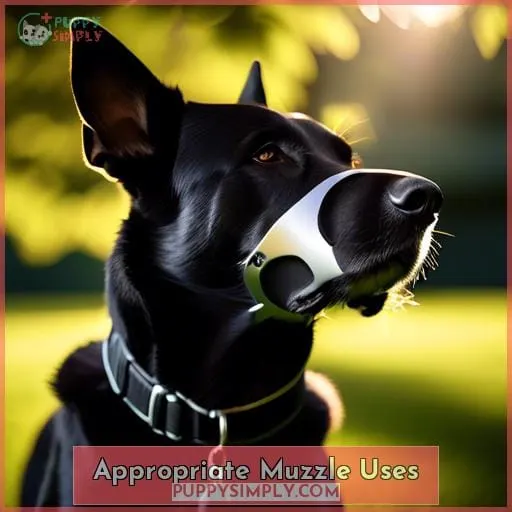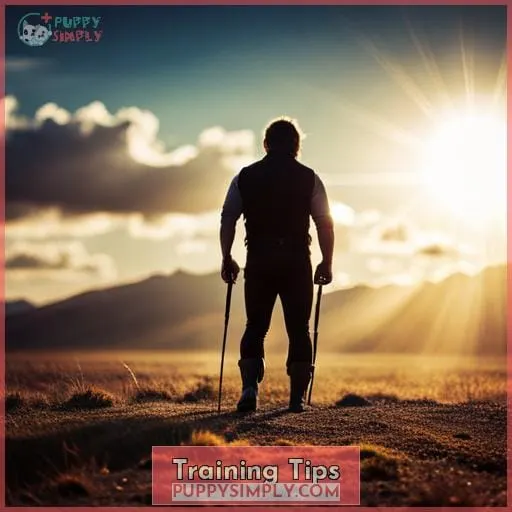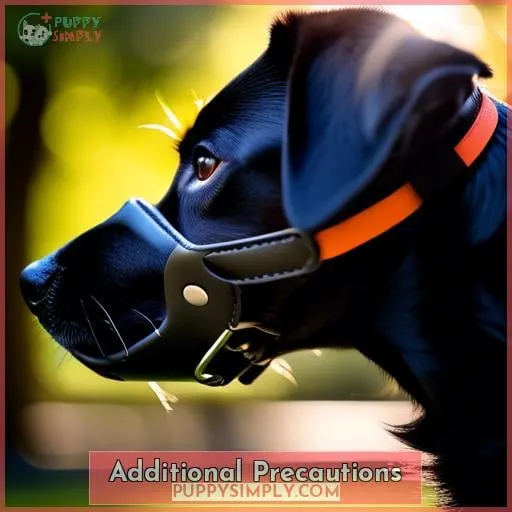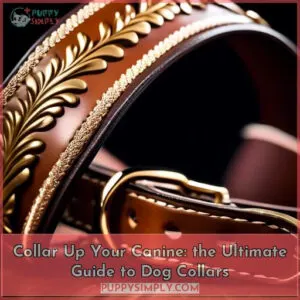This site is supported by our readers. We may earn a commission, at no cost to you, if you purchase through links.
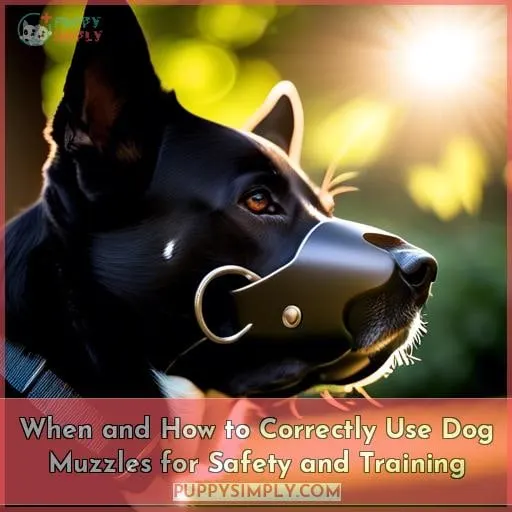 As a wise canine once said, best to nip problems in the bud.
As a wise canine once said, best to nip problems in the bud.
For some pups, this may mean using a muzzle temporarily to keep everyone safe.
Don’t see it as a muzzle of shame — it’s a helpful tool for specific situations.
With patience and training, you can uncover the root of reactivity and phase it out.
But for now, muzzling lets your pup participate without accidental nips.
Stay calm, be consistent, and you’ll both come out the other side better for it.
Table Of Contents
- Key Takeaways
- Removing Muzzle Stigma
- Appropriate Muzzle Uses
- Inappropriate Uses
- Muzzle Types
- Training Tips
- Sizing and Fit
- Maintenance
- Additional Precautions
- Frequently Asked Questions (FAQs)
- How can I tell if my dog is stressed or uncomfortable while wearing a muzzle?
- What should I do if my dog tries to remove the muzzle?
- Can a muzzle affect my dog’s breathing over time, especially during exercise?
- Are there any specific health conditions that make wearing a muzzle unsafe for my dog?
- How do I introduce my dog to other dogs while it’s wearing a muzzle?
- Conclusion
Key Takeaways
- Muzzles are important tools for ensuring safety and preventing bites, especially in stressful situations or for dogs with a history of aggression.
- Muzzles should not be used to address behavioral issues like excessive barking or chewing; instead, training based on positive reinforcement is recommended.
- It is essential to choose the right type of muzzle (basket or soft) for the dog’s comfort and to allow for panting, drinking, and eating as needed.
- Regular cleaning, proper maintenance, and correct fitting of muzzles are crucial for the dog’s well-being, and consultation with a vet is advised for dogs with health conditions.
Removing Muzzle Stigma
You’ve likely heard negative associations with dog muzzles, but it’s time to rethink these assumptions.
Muzzles are useful tools that keep dogs safe in stressful situations, not symbols of aggression.
Listen to experts and use muzzles correctly to aid training and prevent emergencies.
Safety Uses
You might be one of the dog owners with this misconception: Muzzles have legitimate safety purposes and aren’t just for aggressive dogs.
As a veterinarian, I recommend muzzle training for all puppies and dogs.
Muzzles prevent dangerous bites and injuries, while allowing your dog comfort during stressful situations.
With proper training techniques focused on safety, muzzles become vital tools enabling public outings, vet visits, and management of aggression issues.
Veterinary and behavioral experts approve muzzle use for safety, bite prevention, and your dog’s overall well-being.
Expert Opinions
You’re right that muzzles can help keep dogs and people safe in appropriate situations, as experts emphasize:
- Canine behaviorists recommend muzzles to prevent biting during stressful events.
- Veterinarians advise using muzzles post-surgery to avoid interfering with stitches.
- Animal welfare scientists see proper muzzle use as improving public perceptions and dog well-being.
Appropriate Muzzle Uses
You’ll want to use a muzzle in emergencies, such as if your dog is injured or frightened, as well as for dogs with a history of biting or at high risk of biting.
Muzzles can help keep dogs and people safe when introducing potentially stressful or upsetting situations.
However, muzzles shouldn’t be used to force your dog’s mouth closed or as punishment.
Emergencies
Dog behavior:
- Bite history
- Public safety
Muzzle training:
- Behavior modification
- Dog body language
Biting History
Why should a muzzle be considered for dogs with a biting history?
It’s a crucial part of the rehabilitation process, ensuring safety while allowing for effective training techniques.
- Rehabilitation process: Integrates behavioral therapy and positive reinforcement.
- Training techniques: Utilizes a leather basket muzzle to let the dog pant and accept treats.
- Safety measures: Prevents dog bites, protecting both the dog and others during the muzzle use period.
Inappropriate Uses
While muzzles can be a valuable tool for managing your dog’s interactions and ensuring safety, it’s important to recognize when they’re being misused.
Using a muzzle as a form of punishment for behaviors like barking or chewing is inappropriate and can lead to increased stress and anxiety.
Moreover, leaving a muzzle on your dog unsupervised, especially for extended periods, can be dangerous and isn’t a substitute for proper training and behavior modification.
Behavior Problems
Addressing behavior problems with your dog, it’s important to understand that using a muzzle isn’t a solution for issues like excessive barking or chewing.
Instead, focus on training techniques rooted in canine psychology and positive reinforcement.
Muzzles, whether a basket, leather basket, soft, or guardian type, should be part of a broader behavioral solution, not a shortcut to halt training progression.
Punishment
Using a muzzle as a form of punishment not only fails to address the underlying issues behind undesired behaviors but can also significantly harm your dog’s mental well-being.
Behavior Correction:
Muzzles like the royal leather basket muzzle or the DT muzzle should be tools for safety, not discipline.
Training Approaches:
Positive reinforcement is key, not punishment.
Canine Discipline:
Muzzles, even wire basket ones, aren’t meant for discipline.
Behavior Modification:
Gentle leader or other dog muzzle training methods should focus on modifying behavior, not inflicting punishment.
Un Supervised Wear
Leaving your dog unsupervised while wearing a muzzle is a practice you should avoid.
Whether it’s during solo play, outdoor exploration, or nap time, a muzzle isn’t a secure choice.
Even in training sessions or agitation work, constant supervision is crucial.
The DT Freedom muzzle, when a good fit, is excellent for controlled muzzle situations, but remember, your presence is key.
Muzzle Types
Transitioning from discussing the inappropriate uses of muzzles, it’s crucial to be aware of the different types available to ensure your dog’s comfort and safety.
The two primary types are basket and soft muzzles.
Basket muzzles, made of materials like wire, plastic, or leather, allow your dog to pant, drink, and eat, making them ideal for walks, outings, and recovery from surgery.
Soft muzzles, usually made of fabric or leather, wrap around your dog’s mouth, restricting panting, drinking, and eating, and should be worn for short periods.
For colder climates, consider winter muzzles like the DT Freedom Winter, which are designed to prevent potential freezing that might occur with a wire basket.
If your dog has aggression issues, a bite-proof wire basket muzzle can provide a secure solution.
Regardless of the type, proper care is essential, especially for leather components.
Regular cleaning and treating with a quality leather conditioner will keep the muzzle flexible and soft.
Training Tips
After selecting the right muzzle for your dog, it’s time to begin training them to wear it comfortably.
Start by introducing the muzzle during calm moments and rewarding any interest or interaction with treats.
This creates a positive reward association, making your dog more likely to accept the muzzle.
Here are some key training tips to remember:
- Gradually increase the time your dog wears the muzzle, always ensuring their comfort.
This helps them get used to the feel of the muzzle materials against their skin without causing distress.
- Practice emergency preparedness by having your dog wear the muzzle in various situations.
This prepares them for any unexpected events where a muzzle might be necessary.
- Regularly check and maintain the muzzle to ensure it remains in good condition, allowing your dog to drink water and take treats without pinching their cheeks.
Sizing and Fit
After mastering the basics of muzzle training, it’s time to ensure a proper fit for your dog’s comfort and safety.
Proper sizing is crucial. Measure the length of your dog’s snout, ensuring the muzzle is about 1/2 an inch longer than this measurement. The circumference should be 1 to 3 inches larger than your dog’s snout circumference.
These measuring guidelines ensure your dog has enough room to pant, essential for temperature regulation.
Adjustment techniques are key. The straps should be snug but not tight, avoiding restrictions and discomfort. There should be a gap between the muzzle basket and the end of your dog’s nose, ideally around 1 cm.
For wire basket muzzles, use simichrome polish to clean the metal components, especially if your dog loves to eat stuff off the ground. This is particularly important in freezing temperatures, where a rubber-coated muzzle like the DT Freedom Winter model can prevent freezing.
Maintenance
In maintaining your dog’s muzzle, it’s crucial to regularly clean and inspect it for signs of wear and tear to ensure both hygiene and safety.
Cleaning Tips:
- After each use, mechanically clean the muzzle to remove dust, mud, saliva, and other debris.
- For leather muzzles, use a brush or wash in warm water, then dry with a soft cloth.
-
For wire basket muzzles, ensure they’re free from rust. Polymer-coated options are available to avoid rust issues.
Leather Care:
- Treat leather muzzles with a leather conditioner and water repellent to keep them soft, shiny, and durable.
- Ensure these products are non-toxic to avoid allergic reactions in your dog.
-
Regular conditioning prevents the leather from drying out and cracking.
Proper Storage:
- Store the muzzle in a warm, dry place, preferably in a bag made of natural fabric to allow for air circulation.
- This prevents the leather from molding and the metal parts from rusting.
- For wire muzzles, a coated-wire rack can organize and store muzzles efficiently.
By following these maintenance steps, you can extend the life of your dog’s muzzle, ensuring it remains comfortable and safe for your pet to wear.
Additional Precautions
While maintaining your dog’s safety, remember that even the best-fitting muzzles are no substitute for proper training and supervision.
Preventive Measures:
-
Regular training and positive reinforcement.
Risk Assessment:
-
Understanding your dog’s triggers and thresholds.
Emergency Protocols:
-
Having a plan for unexpected situations.
Behavior Analysis:
- Monitoring changes in your dog’s behavior.
Adopting these precautionary measures and adhering to safety protocols will empower you with control and understanding, enhancing the well-being of both you and your furry companion.
Frequently Asked Questions (FAQs)
How can I tell if my dog is stressed or uncomfortable while wearing a muzzle?
Watch for signs like excessive licking, yawning, panting, or whining.
If they’re trying to paw it off, rubbing their face, or showing a stiff body posture, they’re likely stressed.
What should I do if my dog tries to remove the muzzle?
If your dog attempts to remove the muzzle:
- Calmly interrupt the behavior.
- Redirect their attention.
- Reward them for calmness.
Ensure the muzzle fits properly.
Continue positive reinforcement training to build comfort and acceptance.
Can a muzzle affect my dog’s breathing over time, especially during exercise?
Oh, the irony of humans designing a device to keep us dogs from doing what comes naturally, like panting during a game of fetch!
But fear not, if you choose a basket muzzle and fit it properly, your furry friend can still breathe and exercise without turning into a four-legged fish out of water.
Just remember, it’s all about the right fit and type—basket muzzles are the go-to for active pups.
Are there any specific health conditions that make wearing a muzzle unsafe for my dog?
Certain health conditions can make wearing a muzzle unsafe for your dog.
Dogs with respiratory issues or brachycephalic breeds with short snouts can struggle with breathing when muzzled, especially during exercise.
Always consult your vet before using a muzzle.
How do I introduce my dog to other dogs while it’s wearing a muzzle?
Start by letting your dog observe the other dog from a distance, ensuring both are calm.
Gradually decrease the distance, rewarding calm behavior.
Keep initial interactions short and positive, always supervising closely.
Conclusion
So, you’ve turned your pooch into Hannibal Lecter, have you? Fear not, it’s for the greater good.
A muzzle for dogs is a tool, not a scarlet letter. You’re keeping tails wagging safely while addressing underlying issues.
Keep up the maintenance and use muzzles wisely.
With patience and care, you’ll enhance safety and well-being for your four-legged friend and everyone around.


